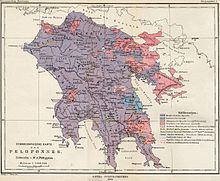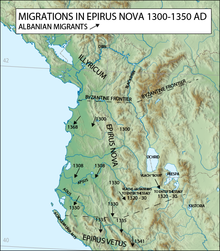Arvanites
The Arvanites ( Greek Αρβανίτες Arvanítes ; Arvanitic Αρbε̰ρεσ̈ε̰ Arbëreshë ) are a bilingual and culturally independent population group in Greece , whose members are of Albanian descent and some of them still speak an archaic Tuscan dialect of the Albanian language . Traditionally and historically, the Arvanites are Orthodox Christians and belong to the Church of Greece .
By seeing themselves as part of the Greek nation, they played a prominent role in nation building. During the Greek Revolution from 1821 to 1829, they provided a large number of soldiers and military commanders, such as Andreas Miaoulis (1769-1835), Laskarina Bouboulina (1771-1825) and others . But Arvanite intellectuals and clergy also took an active part in shaping and modernizing the Greeks. Today, therefore, they are an integral part of the modern Greek nation. Although they are aware of their independence, most Arvanites see themselves as Greeks today and are therefore often hardly distinguishable from other Greeks.
Popular name
The popular name comes from Byzantine chroniclers who first mentioned the Arvanites ( ancient Greek altρβανίται Arvanítai ) originating from Arvanon . The modern Albanian name of the state of Albania and the associated popular name - Shqipëri / Shqipëria and Shqiptarë / Shqiptarët (each indefinite and definite form) - were not known to these settlers in the Middle Ages.
The Çamen , who have an Albanian national consciousness and are predominantly Muslim, are to be distinguished from the Arvanites - the Arvanites, on the other hand, traditionally profess Orthodox Christianity . Also to be differentiated from the Arvanites are the Christian-Orthodox Soulioten , who also participated in the formation of Greek nations, but were culturally and geographically closer to the Çamen. A third Albanian group are migrants from Albania who immigrated to Greece from the 1990s.
distribution

According to the criteria of linguistic usage, it is estimated that between 25,000 and 200,000 Arvanites live in Greece. Today most of the Arvanites live in southern Greece, but also on some Aegean islands and the Peloponnese , in what is now the border triangle in Thrace and Epirus .
A census in what was then Greece in 1879 is said to have shown that around 225,000 Arvanites lived in the Peloponnese , central Greece, Euboea and Andros . At that time Greece had a total population of about 1.6 million people. Hydra and Spetses , considered "traditionally Arvanitic", were not included in this census.
history
In the 13th century, the first Albanians came to Greece at the invitation of local rulers. They were in demand as peasants as well as mercenaries for the troops of the Duke of Athens , the Despot of Morea and other princes. But even on its own to Albanian tribes settled in the only sparsely populated by the constant wars regions Thessaly , Boeotia , Attica , South Euboea , Corinth , Argolis , West Laconia (both on the Peloponnese ) and on many islands of Saronen and Cyclades settled in the Aegean Sea . They settled there in their own villages. The influx continued into the 15th century. Around the year 1400, the number of Albanians (Arvanites) in Morea was estimated at around 10,000. In 1450 that number rose to 30,000. The Orthodox Tosks , who had settled in central and southern Greece, soon lost contact with their areas of origin. They lived among the Greeks. In their villages they spoke Albanian dialects well into the 20th century, which over time, however, incorporated more and more Greek elements. At the end of the 15th century, some of the Arvanites fled from the Ottomans advancing in the Balkans to southern Italy and Sicily and strengthened the Albanian émigré communities of the so-called Arbëresh .
The Arvanites took an active part in the development of the modern Greek nation and in the liberation struggle against the Ottomans since the 18th century. Like the Greeks, their Christian-Orthodox identity was transformed into a modern national consciousness. Since the founding of the Greek state and as a result of domestic and foreign policy conflicts (including with Albania), the Arvanite dialects were little respected, and over time most of the Arvanites switched to the Greek language . This process accelerated after the Second World War through rural exodus and urbanization . Today only remnants of the Arvanitika are preserved. Old traditions and customs are still cultivated, especially in folklore .
language
Arvanitika ( Greek αρβανίτικα arvanítika ) is the name of the Albanian dialect that is only spoken to a limited extent in Greece today. It belongs to the Tuscan sub-dialect of Albanian and has received considerable influences from various Greek dialects on all language levels. Arvanitika is the Greek name for the language, which has now also been adopted by the speakers themselves. The own language name arbërisht is hardly used anymore.
Today the Arvanitika is one of the most threatened languages in Europe. The rapid decline in the number of speakers after the Second World War and even more so after the 1970s is due to various socio-economic reasons and not least to the negative status in Greek society, including the language communities themselves.
Famous Arvanites
- Andreas Miaoulis (1769-1835), Admiral
- Laskarina Bouboulina (1771–1825), participant in the Greek revolution
- Georgios Koundouriotis (1782–1858), politician and Prime Minister of Greece
- Antonios Kriezis (1796–1867), politician and former Prime Minister of Greece
- Dimitrios Voulgaris (1802–1868), politician and former Prime Minister of Greece
- Athanasios Miaoulis (1815–1867), politician and former Prime Minister of Greece
- Pavlos Koundouriotis (1855–1935), admiral, two-time viceroy and President of Greece
- Alexandros Diomidis (1875–1950), politician and Prime Minister from 1949 to 1950
- Theodoros Pangalos (1878–1952), general in the Greek army and politician
- Nikos Engonopoulos (1907–1985), painter and poet
- Hieronymos II. (* 1938), Greek Orthodox clergyman, Archbishop of Athens since 2008 and head of the autocephalous Orthodox Church of Greece
- Theodoros Pangalos (* 1938), politician and deputy prime minister from 2009 to 2012
See also
literature
- Jakob Philipp Fallmerayer: The Albanian Settlement of the Peloponnese in the Middle Ages . In: History of the Morea Peninsula during the Middle Ages. A historical attempt, Part Two . Verlag der JG Cotta'sche Buchhandlung, Stuttgart 1836, p. 240–263 ( online version [accessed December 5, 2016]).
- Eric P. Hamp: On the Arvanitika Dialects of Attica and the Megarid . In: Balkansko ezikoznanie Балканско езикознание . tape 3 , no. 2 , 1961, ISSN 0324-1653 , pp. 101-106 .
- Claus Haebler: Grammar of the Albanian dialect of Salamis . In: Albanian Research . tape 3 . Harrassowitz, 1965, ISSN 0568-8957 (also: Saarbrücken, University, habilitation paper, 1962).
- Georg Stadtmüller : Research on Albanian early history . In: Albanian Research . 2nd, expanded edition. tape 2 . Harrassowitz, Wiesbaden 1966 (at the same time: Breslau, university, habilitation paper, 1936).
- Alain Ducellier: L'Arbanon et les Albanais au XIe siècle . In: Travaux et Mémoires . tape 3 , 1968, ISSN 0577-1471 , pp. 353-368 .
- Titos P. Jochalas: About the immigration of the Albanians in Greece. A summary consideration . In: Peter Bartl and others (editor): Dissertationes Albanicae. In honor of Josephi Valentini et Ernesti Koliqi septuagenariorum (= contributions to knowledge of Southeast Europe and the Near East ). tape 13 . Trofenik, 1971, ZDB -ID 1072151-4 , p. 80–106 (Also as a special edition. Trofenik, Munich 1971).
- Lukas D. Tsitsipis: Language change and language death in albanian speech communities in Greece. A sociolinguistic study . Madison (Wisconsin) 1981 (PhD thesis).
- Walter Breu: Linguistic minorities in Italy and Greece . In: Bernd Spillner (Ed.): Intercultural Communication . Congress contributions to the 20th annual conference of the Society for Applied Linguistics GAL eV (= Forum Applied Linguistics ). tape 21 . Lang, Frankfurt am Main 1990, ISBN 3-631-42888-X , p. 169-170 .
- Hans-Jürgen Sasse: Arvanitika. The Albanian language remnants in Greece . tape 1 . Harrassowitz, Wiesbaden 1991, ISBN 3-447-02758-4 .
- Jana Willer-Gold, Tena Gnjatović, Daniela Katunar, Ranko Matasović: Multilingualism and structural borrowing in ArbanasiAlbanian . University of Zagreb, 2016 (English). , accessed February 26, 2017
Web links
- Eleni Botsi: The linguistic self-construction and external construction using the example of an Arvanite village in Greece. A Sociolinguistic Study. Dissertation at the University of Konstanz 2004, full text.
- Konrad Clewing: Albanian speakers and Albanians in Greece and Greeks in Albania . In: pogrom - threatened peoples . 2005.
Individual evidence
- ^ David Sutton: Resistance, Misrecognition, or Identity? Images of Rural and Urban in Three Recent Greek Ethnographies . In: Anthropological Quarterly . tape 71 , no. 4 , 1998, ISSN 0003-5491 , pp. 203-211 .
- ↑ Michaelis Attaliotae Historia, ed. v. August Immanuel Bekker (= Corpus scriptorum historiae Byzantinae. 47). Bonn 1853. Anna Comnena: Alexias , translated a. ed. v. Diether Roderich Reinsch. Berlin 2001. ISBN 3-11-017195-3 .
- ^ Jan Markusse: Territoriality in national minority arrangements: European-wide legal standards and practices. In: Gertjan Dijkink, Hans Knippenberg (eds.): The Territorial Factor. Vossiuspers UvA, Amsterdam, 2001, p. 260, table 12.1.
- ^ Society for Threatened Peoples
- ^ A b Theodore G. Zervas: Learning Arvanitic in Late 19th and Early 20th Century Greece . Linguistic Maintenance and Cultural Idiosyncrasies in Greece's Arvanitic Speaking Communities. In: Journal of Balkanology . tape 50 , no. 2 , 2014, p. 269 ( zeitschrift-fuer-balkanologie.de [accessed on September 9, 2017]).
- ↑ Miranda Vickers: Shqiptarët. Një histori modern . Bota Shqiptare, sl 2008, ISBN 978-99956-11-68-2 , Hyrje, p. 16-17 (English: The Albanians. A Modern History . Translated by Xhevdet Shehu).
- ↑ Bulletin No. 9. Society for Threatened Languages eV ( University of Cologne ), August 2003, accessed on January 4, 2013 (PDF file; 194 KB; p. 9).


